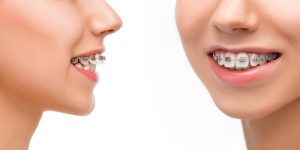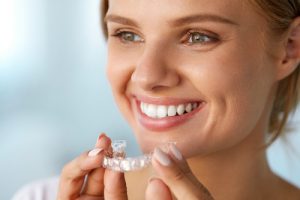Orthodontic conditions are typically referred to as “malocclusion.” This term can encompass many different types of issues related to misalignment of the jaws and/or teeth. Malocclusion is very common, and some individuals have more severe forms of it than others. Whether mild, moderate, or severe, orthodontic conditions can affect the health, function, and appearance of the teeth. Fortunately, our board certified orthodontist, Dr. Chris Murphy, performs a number of advanced orthodontic procedures designed to correct a full range of conditions. These treatments can improve overall function and rejuvenate your smile with beautiful results.
Below, you will find some of the more common orthodontic conditions we see here at Murphy Orthodontics. If you would like more information on orthodontic treatment options, or if you would like to schedule a consultation, please contact us today.
- Spaces Between Teeth
- Teeth Crowding
- Overbite / Deep Overbite
- Underbite
- Crossbite
- Open Bite
- Missing Lateral Incisors
- Overjet (Protrusion)
Spaces Between Teeth
 Excessive spaces and gaps between the teeth can be the result of lost teeth, the failure of teeth to properly develop, or other issues. This can have a noticeable effect on one’s appearance and even cause problems with chewing and speaking. Orthodontic treatments such as Invisalign® and various types of braces can correct teeth misalignment and bring the teeth into a more desirable position.
Excessive spaces and gaps between the teeth can be the result of lost teeth, the failure of teeth to properly develop, or other issues. This can have a noticeable effect on one’s appearance and even cause problems with chewing and speaking. Orthodontic treatments such as Invisalign® and various types of braces can correct teeth misalignment and bring the teeth into a more desirable position.
Teeth Crowding
Teeth crowding indicates that there are areas of the teeth that are too close together, or “bunched up.” This is typically the effect of the permanent teeth not having enough room to properly align themselves when they come in. Braces or Invisalign® can be very effective treatment options for teeth crowding.
Overbite / Deep Overbite
 An overbite is characterized by the upper teeth overlapping the lower teeth to some degree. A more severe form of overbite is called a “deep overbite,” which occurs when the upper front teeth are extending completely over the lower front teeth. Overbite conditions can affect an individual’s facial appearance as well as chewing ability. They can also lead to headaches, hearing difficulties, and TMJ Disorder, in addition to causing the lower teeth to wear down. Orthodontic techniques such as braces have often shown to be a good solution to overbite and deep overbite conditions. For patients who have milder forms of overbite, Invisalign® may also be an option.
An overbite is characterized by the upper teeth overlapping the lower teeth to some degree. A more severe form of overbite is called a “deep overbite,” which occurs when the upper front teeth are extending completely over the lower front teeth. Overbite conditions can affect an individual’s facial appearance as well as chewing ability. They can also lead to headaches, hearing difficulties, and TMJ Disorder, in addition to causing the lower teeth to wear down. Orthodontic techniques such as braces have often shown to be a good solution to overbite and deep overbite conditions. For patients who have milder forms of overbite, Invisalign® may also be an option.
Underbite
When the lower teeth and lower jaw extend further than the upper teeth, the condition is called an underbite. This common orthodontic concern can have an effect on chewing and other functional issues, as well as the aesthetic of the lower face. Customized orthodontic appliances and braces can often be ideal treatments for an underbite.
Crossbite
 Crossbite occurs when the jaws are not properly aligned, causing the upper teeth (typically the back areas) to sit inside the corresponding lower teeth. Crossbite can take a number of different forms, and it can involve a single tooth or multiple teeth. Treatment options that can be effective for crossbite conditions include a palatal expander (mostly utilized for children), braces, Invisalign®, or other orthodontic appliances.
Crossbite occurs when the jaws are not properly aligned, causing the upper teeth (typically the back areas) to sit inside the corresponding lower teeth. Crossbite can take a number of different forms, and it can involve a single tooth or multiple teeth. Treatment options that can be effective for crossbite conditions include a palatal expander (mostly utilized for children), braces, Invisalign®, or other orthodontic appliances.
Open Bite
An open bite is typified by the upper front teeth’s inability to meet the lower front teeth. This condition can cause improper chewing and other concerns. Headgear and other orthodontic appliances can often be helpful in the correction of open bite issues.
Missing Lateral Incisors
The lateral incisors are typically located on each side of the front teeth. Sometimes, they simply do not develop, and the upper cuspids gravitate toward the front teeth to take the place of the missing lateral incisors. Both the appearance and function of the teeth can be affected by this condition. In most cases, braces can be utilized to create new spaces on the sides of the front teeth, and dental implants can then be placed to fill the gaps.
Overjet (Protrusion)
An overjet indicates a protrusion of the upper jaw over the lower teeth, which can affect dental function as well as facial appearance. While an overjet may be partly caused by genetics, this condition has also been linked to thumb-sucking and long-term use of a pacifier or bottle. Orthodontic appliances, Invisalign®, and braces have shown to be effective correction techniques for overjet conditions.